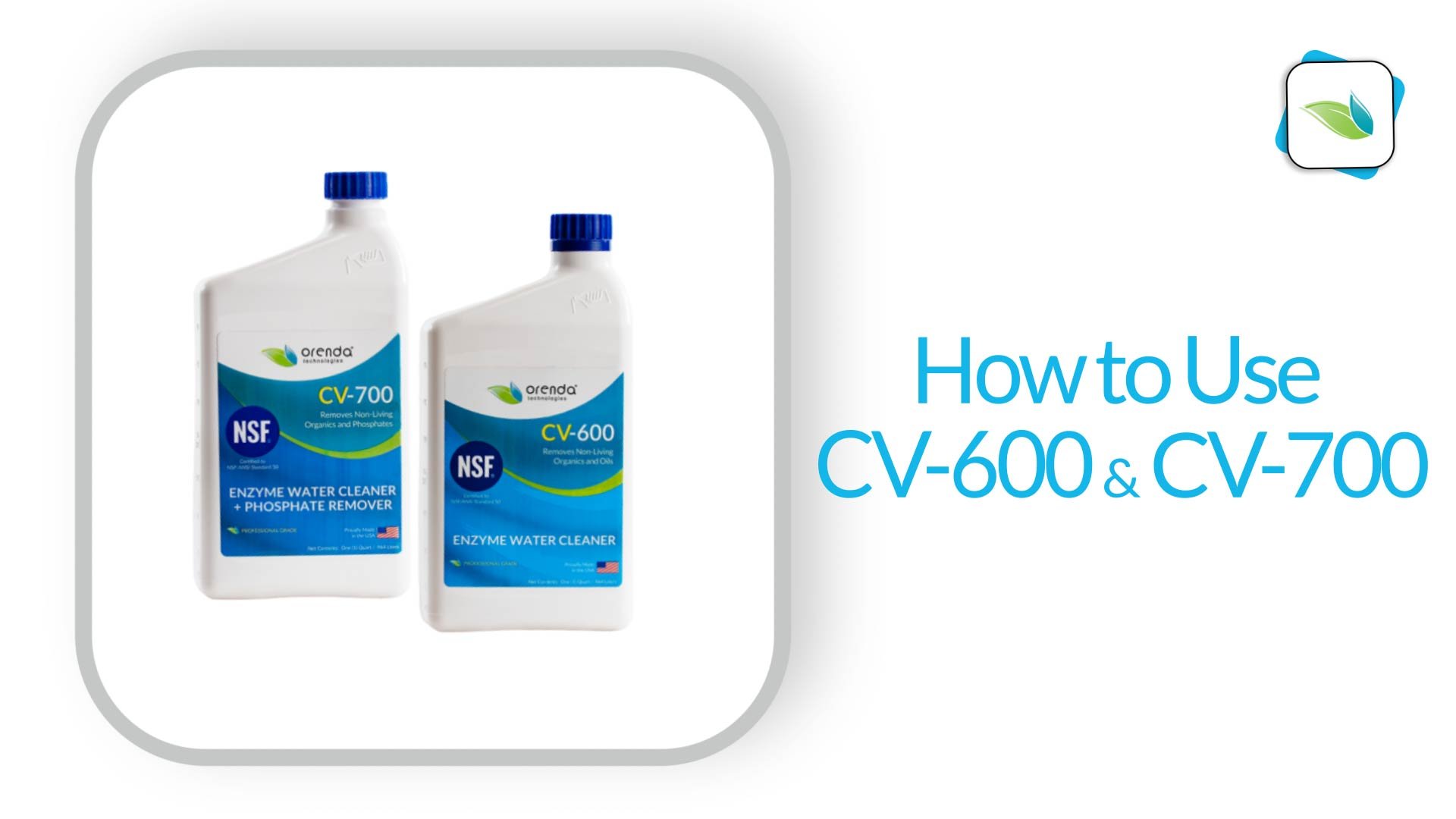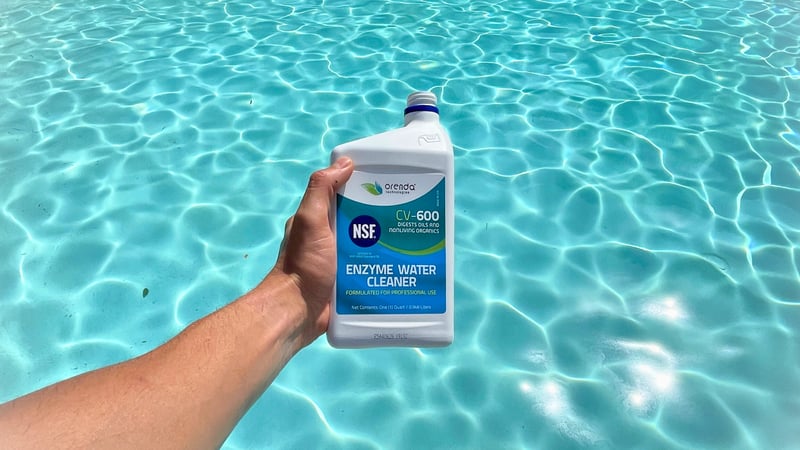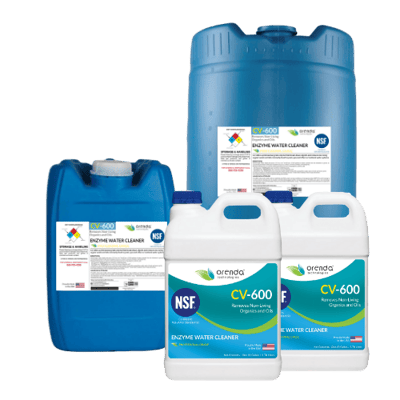How to Use CV-600 and CV-700

How to use CV-600 and CV-700 Enzymes
Overview
CV-600 and CV-700 are enzyme products. They break down and remove non-living organics and oils from water. This procedure covers different ways enzymes can be used in your swimming pool, proper dosing instructions, and frequently asked questions (FAQs).
Related: How to Implement the Orenda Program
You may need:
-
- Plastic measuring cup (for liquids)
CV-600 and CV-700 dosing rates
Our enzyme products have two dosing rates: the initial purge dose, and the weekly maintenance dose.
|
CV-600/700 Dose |
Dose per 10,000 gallons (37,900 L) |
| Purge/Startup | 32 fl. oz. (0.94 L) |
| Weekly (residential) | 3-5 fl. oz. (89-147 mL) |
| Weekly (commercial) | 5-10 fl. oz. (147-295 mL) |
| Weekly (swim schools and waterparks) | 10-20 fl. oz. (325-591 mL) |
An Orenda enzyme purge for your pool is similar to a deep herbal cleanse of your body. Enzymes are a natural way to clean out the pipes, filters, and the rest of the swimming pool system. They target and break down non-living, carbon-chain organic materials. These non-living organics are usually in the form of grease, oils, and other bather waste. Specifically, body products like deodorant, lotions, oils, cosmetics, and sunscreen. There are also natural organics like tannins and decaying leaves and grass clippings.
Always begin an enzyme program with the purge dose. The purge dose conquers the non-living organics out of the water, and also leaves a residual of enzymes in circulation. The weekly maintenance dose is to keep that residual in the water throughout the season. Enzymes eventually get used up, and the more bather demand in the water, the more enzymes will be needed to keep the water clean.
Where and how to pour CV-600 and CV-700 into a pool
 It does not particularly matter where you pour CV-600/700. It can be poured around the perimeter of the pool, or directly into the skimmer or gutter for circulation. We prefer it to be circulated immediately, at least for the weekly maintenance doses. The purge dose can be added just about anywhere. For manual dosing, measure the enzymes with a plastic measuring cup and pour them in. No dilution is necessary.
It does not particularly matter where you pour CV-600/700. It can be poured around the perimeter of the pool, or directly into the skimmer or gutter for circulation. We prefer it to be circulated immediately, at least for the weekly maintenance doses. The purge dose can be added just about anywhere. For manual dosing, measure the enzymes with a plastic measuring cup and pour them in. No dilution is necessary.
If you are operating a commercial or residential pool with chemical automation, the feeder for CV-600 or CV-700 should be plumbed into the surge tank or into the line just before the filter. You could also add it on the return line. As mentioned before, enzymes can be added just about anywhere.
Scum line removal and prevention
Scum lines are the result of non-living organics and oils that float to the surface, and stick to the walls along the water line. Generally speaking, scum lines exist when the oxidant demand overwhelms the chlorine.
To remove scum lines, we recommend purging the pool with enzymes if you have not already done so (if you have, and scum lines are still there, you probably need to up the weekly maintenance dose). Once the enzymes are in, simply clean the tile line with a scrub brush. Alternatively, you could deliberately raise the water level–much like you would for SC-1000 to soften and remove a scale line–and let the enzyme-treated water soak the scum line for a week. If a scumline exists after a week, it should be softened enough to easily brush off.
To prevent scum lines, maintain the pool on the appropriate amount of enzymes each week. The weekly maintenance dose depends on the bather demand.
CV-600 and CV-700 considerations
Enzymes are temperature-sensitive. The warmer the water, the better and faster they work. We recommend purging in the springtime when opening pools. As the water warms up, the enzymes continue to work.
Enzymes need oxygen to work. The more agitation and circulation in the water, the better enzymes perform. But this can be a two-sided sword too, because too much agitation can lead to temporary foaming. The foaming is harmless, but annoying.
Do not let CV-600 or CV-700 freeze. If the products never freeze, Orenda enzymes have an indefinite shelf life (100+ years). If they do freeze, coagulation can occur and the enzymes are less effective.
CV-600 and CV-700 FAQs
 How long until it is safe to swim after using CV-600 or CV-700?
How long until it is safe to swim after using CV-600 or CV-700?
You can swim immediately. You can add enzymes while people are in the pool too.
Like all Orenda products, both CV-600 and 700 are certified to NSF/ANSI Standard 50. That means when used as directed, they are nontoxic and nonhazardous in your water. In fact, they used to be certified to NSF-60, which was a drinking water standard. We have not changed the formula at all, but we chose to let the certification lapse, as we focus on swimming pool water, not drinking water.
Do CV-600 and CV-700 leave behind a residual?
Yes. Both leave behind a residual from the purge dose, and the weekly maintenance is designed to replenish that residual as it gets used up on organic material. One note, however, with CV-700. CV-700 contains a phosphate remover (not PR-10,000, by the way). That phosphate remover reacts on contact with phosphates and will not leave behind a residual. Only the enzymes do.
What else can CV-600 and CV-700 be used for?
Our enzymes are used in almost all of our procedures. The Orenda Startup™ uses enzymes when circulation begins to clean out the pipes and remove the oils off the fresh pool surface. The Green Pool Cleanup process needs enzymes to remove non-living organics, which allows for better flocculation and removal of phosphates and other debris in the water (oil floats, dirt falls). We also use enzymes to purge sand filters and to clean filter cartridges. We use enzymes to help clean scum lines too.
Can CV-600 and CV-700 be used in saltwater pools?
Yes.
What is the shelf life of CV-600 and CV-700?
Indefinite shelf life (100+ years), provided the product does not freeze.
